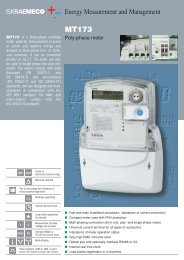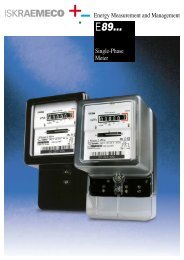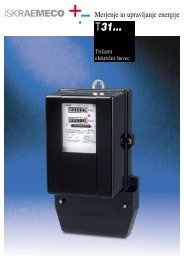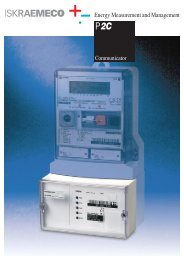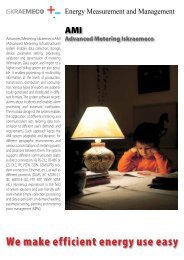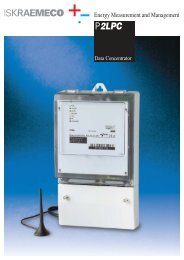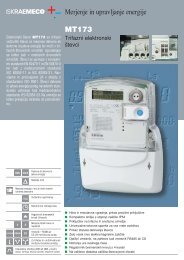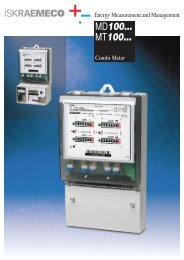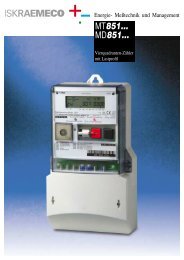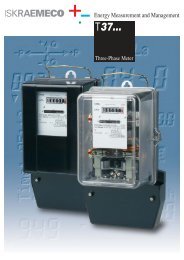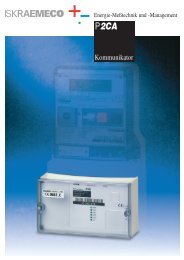E7_E8_prospect.pdf - Iskraemeco
E7_E8_prospect.pdf - Iskraemeco
E7_E8_prospect.pdf - Iskraemeco
You also want an ePaper? Increase the reach of your titles
YUMPU automatically turns print PDFs into web optimized ePapers that Google loves.
Energy Measurement and Management<br />
<strong>E7</strong>2..-01<br />
Single-Phase<br />
Meter
<strong>E7</strong>2..-01<br />
APPLICATION<br />
The electricity meter type <strong>E7</strong>2..-01 is suitable for measuring active<br />
energy for direct connection in single-phase, two-wire networks.<br />
COMPLIANCE WITH STANDARDS<br />
The measuring and technical qualities of the meter <strong>E7</strong>2..-01 comply<br />
to International Electrotechnical Commission Publications (IEC 521),<br />
German Standard (VDE 0418)...<br />
Their construction and mechanical dimensions comply with<br />
DIN 43 857 and all respective DIN dimensional standards. Its<br />
construction enables adaptation to various requests in the<br />
measuring and technical qualities.<br />
The accuracy class is 2.<br />
FEATURES<br />
• Long term stability and high reliability<br />
• Fully temperature compensated from –20 °C to +50 °C<br />
• High impulse level protection<br />
• High accuracy load ranges<br />
• Small influence quantities<br />
• Low self-consumption of coils<br />
• Easy for maintenance<br />
• Service life expectancy 30 years<br />
• Inductive pulse transmitters<br />
• Distinguished by its measuring and technical qualities<br />
• Minimum risk of accidents at the measuring place<br />
SETTING ELEMENTS<br />
Setting elements are easily<br />
accessible and are manually<br />
adjusted without special tool.<br />
Interactive setting influences are<br />
at a minimum.<br />
2<br />
3<br />
5<br />
6<br />
4<br />
1<br />
1 – starting adjustment<br />
2– coarse setting of rotor<br />
speed (± 8%)<br />
3 – fine setting of rotor<br />
speed (± 1%)<br />
4 – setting of auxiliary<br />
moment at small load<br />
(± 10%)<br />
5 – coarse phase setting<br />
(one ring is +2 % approx.)<br />
6 – fine phase setting<br />
(± 1,5% approx.)
<strong>E7</strong>2..-01<br />
CONSTRUCTION<br />
Base and cover<br />
The case comprises base and<br />
cover of moulded insulating<br />
black material (Bakelite) highly<br />
resistant to creep currents.<br />
Improved version of the meter<br />
case enables better sealing of<br />
the meter cover and the base<br />
by means of Perbonane sealing<br />
gasket inserted in the groove of<br />
meter cover. It prevents penetration<br />
of dust and humidity into<br />
the meter interior.<br />
Degree of protection level complies<br />
to IEC 529 - IP 53.<br />
Both, the bakelite or the thermoplastic<br />
transparent meter cover<br />
can be applied to the meter.<br />
The meter cover is fixed to the<br />
base diagonally by two captive<br />
sealing screws.<br />
The bakelite cover is provided<br />
with a glass window through the<br />
meter can be read and the rotor<br />
observed. The window is fixed in<br />
the cover by means of a frame<br />
held in position and<br />
by four fixing washers and<br />
sealed by silicon material.<br />
The transparent meter cover is<br />
made of solid, self-extinguishable,<br />
thermoplastic material.<br />
The hanging hook and two<br />
bores for fixing the meter are<br />
also provided on the meter<br />
base.<br />
Terminal block:<br />
This is an integral part of the<br />
meter base and is dust proof.<br />
The brass terminals are inserted<br />
into the terminal aperture from<br />
the front side of the meter base.<br />
In addition the shutter made of<br />
solid, self-extinguishable, thermoplastic<br />
material is screwed<br />
over the terminal after built - in<br />
them. Maximum diameter of the<br />
terminal hole is 6,5 mm or on<br />
special request 7 mm, which<br />
enable the connection of outer<br />
wires more than 25 mm2. Fixing<br />
of outer wire is provided by<br />
means of two M6 screws. Diameter<br />
of the auxiliary terminal hole<br />
is 3,2 mm.<br />
The voltage circuit can be disconnected<br />
from the current circuit<br />
in two ways :<br />
– under the terminal cover by<br />
removing the terminal link<br />
and / or<br />
– under the main meter cover<br />
by removing the voltage coil<br />
connection from current to<br />
voltage terminal.<br />
Terminal cover<br />
There are two terminal covers<br />
available - short which covers<br />
only the terminal compartment<br />
and extended which extends<br />
below the meter. Both covers<br />
are sealed independently from<br />
the meter case.<br />
Carrying frame<br />
is made of die - cast SiAl alloy,<br />
which enables high mechanical<br />
strenght and stability during the<br />
long time operation period. The<br />
carrying frame is fixed by two<br />
self-cut thread screws to the<br />
bakelite bearer made on the<br />
moulded meter base.<br />
Driving system<br />
The tangentional driving element<br />
is fixed to the robust carrying<br />
frame and consists of separate<br />
voltage and current electromagnets.<br />
The voltage coil is wound onto a<br />
thermoplastic frame covered by<br />
PVC shrinking tube. It can be<br />
additionally insulated by<br />
polyurethane resin to give higher<br />
breakdown resistance.<br />
The current coil is synthetic<br />
resin insulated wire formed<br />
around a thermoplastic frame<br />
and give additional insulation<br />
against the current core and the<br />
carrying frame.<br />
TECHNICAL DATA<br />
Meter type <strong>E7</strong>2B.. <strong>E7</strong>2C.. <strong>E7</strong>2E.. <strong>E7</strong>2F..<br />
Reference voltage<br />
230 V<br />
Special version<br />
from 100 V to 500 V<br />
Reference frequency<br />
50 Hz (special version 60 Hz)<br />
Consumption of voltage<br />
1 W<br />
electromagnet at 230 V, 50 Hz<br />
3,9 VA<br />
Basic current (A) 10 5 10 10 5 10<br />
Maximum current (A) 30 20 40 50 30 60<br />
Thermal current 1,2 Imax (A) 36 24 48 60 36 72<br />
Consumption of current 0,18 W 0,14 W 0,18 W 0,12 W 0,12 W 0,12 W<br />
electromagnet at basic current 0,35 VA 0,33 VA 0,35 VA 0,23 VA 0,23 VA 0,23 VA<br />
Specific speed (r.p.m.) 23 14,375<br />
Rated torque at Ur, Ib, fr, from 4,00 to 4,70 x 10 -4 Nm approx.<br />
Starting current<br />
0,45 % Ib<br />
No-load running<br />
there is no no-load running from 80 % to 110 % Uref<br />
Dielectric strength<br />
2000 V, 1 min.<br />
Surge voltage strength 1,2/50 µs<br />
> 7 kV<br />
Rotor weight<br />
– meters with magnetic bearings 27 g<br />
– meters with dual-cup bearing 24 g<br />
Weight of meter<br />
cca. 1,3 kg<br />
Alternatively, other current ranges to maximum 60 A are also possible !
<strong>E7</strong>2..-01<br />
Both voltage and current coils<br />
can easily be replaced.<br />
Electromagnetic sheets of a corresponding<br />
initial permeability in<br />
current cores assures specified<br />
error curves with respect to the<br />
load, either at small loads or<br />
overloads. Electromagnetic sheet<br />
metal for laminations of voltage<br />
and current cores as well as for<br />
other parts has been previously<br />
selected by uniform electric<br />
magnetic characteristics.<br />
A special combination of the<br />
stray current connection and<br />
previous magnetisation of current<br />
core with voltage magnetic<br />
flux, enables high accuracy of a<br />
whole wide load range.<br />
Bearings<br />
Upper bearing is a pin type and<br />
serves as an axial rotor guide. A<br />
pin made of stainless steel<br />
spindle smoothly slides in the<br />
sintered graphite bearing. The<br />
pin is pressed into the brass<br />
sleeve. A sleeve with the pin is<br />
fastened to the meter frame. The<br />
bearing has exceptionally small<br />
and time constant friction and<br />
should not be lubricated.<br />
Lower bearing is of two cup or<br />
magnetic type.<br />
The two-cup bearing<br />
A highly polished steel ball,<br />
greased with high-quality oil<br />
against corrosion, lies<br />
between two sapphire cups.<br />
The bearing features minimum<br />
start friction and considerably<br />
long life. The bearing insert is<br />
elastically located to prevent<br />
damage during transportation<br />
and to enable easy replacement<br />
by pressing the bearing<br />
insert, without need of readjustment<br />
of the bearing height.<br />
TYPICAL PERFORMANCE CHARACTERISTIC<br />
LOAD CURVE<br />
+2<br />
+1<br />
F %<br />
-1<br />
-2<br />
5 20 100 200 300 400 500 600 Ib %<br />
10<br />
P.F.=1<br />
L.F.=0.5<br />
INFLUENCE OF VOLTAGE VARIATION<br />
+2<br />
+1<br />
p %<br />
-1<br />
-2<br />
90 100 110% Ur<br />
10% Ib<br />
INFLUENCE OF FREQUENCY VARIATION<br />
+2<br />
+1<br />
p %<br />
-1<br />
-2<br />
95 100 105% fr<br />
+2<br />
+1<br />
p %<br />
-1<br />
-2<br />
90 100 110% Ur<br />
Imax/2<br />
+2<br />
+1<br />
p %<br />
-1<br />
-2<br />
95 100 105% fr<br />
+2<br />
+1<br />
p %<br />
-1<br />
-2<br />
90 100 110% Ur<br />
Imax<br />
+2<br />
+1<br />
p %<br />
-1<br />
-2<br />
95 100 105% fr<br />
ERROR DUE TEMPERATURE VARIATION<br />
+2<br />
+1<br />
F %<br />
-1<br />
-2<br />
-20<br />
-10 0 +10 +20 +30 +40 +50 °C<br />
10% Ib — Imax P.F.=1<br />
20% Ib — Imax L.F.=0.5
<strong>E7</strong>2..-01<br />
The magnetic type<br />
It is designed as a carrying<br />
bearing. The repulsive magnetic<br />
field of both bearing<br />
parts completely compensates<br />
the rotor weight. The upper<br />
part of the magnetic bearing<br />
is pressed on to the rotor<br />
shaft together with the<br />
graphite guide. The lower part<br />
of the magnetic bearing is<br />
fixed to the meter frame<br />
together with a guiding pin<br />
and brass internal and external<br />
sleeves. A plate for temperature<br />
compensation is a<br />
part of the lower magnet<br />
assembly, as well. A guiding<br />
pin is made of quality stainless<br />
steel. It is rounded on the<br />
lower part in order to prevent<br />
damages of the bearing surfaces.<br />
The bearing has small and<br />
time constant friction what<br />
assures long life of the meter.<br />
No lubrication of the bearing<br />
is required. The bearing<br />
height can be set and there is<br />
no need to reset the height in<br />
case of rotor replacement.<br />
Rotor<br />
It is made from aluminium sheet<br />
selected for its conductivity and<br />
purity. It is free from particles of<br />
ferrous metal. The meter rotor is<br />
relatively light-weight, circular,<br />
90 mm in diameter and 1,2 mm<br />
thick, die-cast with aluminium<br />
alloy to a stainless steel shaft.<br />
The disc has a black mark<br />
which helps count the revolutions<br />
on the disc for testing purposes.<br />
On request 100 radial,<br />
equal black divisions can be<br />
printed around the circumference<br />
to allow stroboscopic calibration<br />
and testing.<br />
The register is driven by a<br />
moulded worm, made of<br />
polyamide, which is fitted to the<br />
spindle. A graphite sleeve is<br />
impressed into the worm on the<br />
upper side of the shaft.<br />
Braking magnet<br />
It is a two-direction version. The<br />
U-shaped magnetic cubes are<br />
of AlNiCo alloy with high coercivity<br />
which reduces the influence<br />
of short-circuit thrusts on<br />
the measuring accuracy of the<br />
meter.<br />
A wide range of the rotor<br />
speed adjusting is possible by<br />
moving the entire magnet unit,<br />
and fine speed adjusting is<br />
guaranteed with a micro-meter<br />
control.<br />
From side of magnetic cube<br />
there is a temperature compensation<br />
material compensating<br />
registration changes in respect<br />
of temperature variations in a<br />
wide temperature range.<br />
The Register<br />
Single-rate register consists of<br />
six or seven graduated drums.<br />
The periphery of the last drum is<br />
divided in 100 sections. Thin<br />
polished axles are rotating in<br />
plastic bearings causing minimum<br />
friction and high error stability<br />
at small loads. No lubrication<br />
of bearings is necessary.<br />
The register framework can be<br />
fastened to the meter framework<br />
with one screw without an<br />
adjustment plate, so that the<br />
worm and the worm wheel fit<br />
each other completely.<br />
Single-rate register is provided<br />
with standard digit drums with<br />
the size of numbers 4,7 x 2,3<br />
mm and decimal code numbers.<br />
Alternatively, a single-rate register<br />
with larger digit drums with<br />
size of numbers 6,9 x 3,65 mm<br />
is available.<br />
Two-rate register consists of six<br />
or seven graduated drums for<br />
each tariff. The tariff switchover<br />
is enabled by a change-over<br />
relay functioning via differential<br />
gear. Thus the register display<br />
error at switchover from the first<br />
to the second tariff and vice-versa<br />
is eliminated. The changeover<br />
relay is a D.C. version supplied<br />
via the incorporated rectifier<br />
and protective resistor. Relay<br />
self-consumption is 1,8 VA. The<br />
upper register is active in the<br />
first rate when the relay is not<br />
supplied while the lower one is<br />
active when the relay is supplied.<br />
Alternatively, when<br />
desired, this can be reversed.<br />
Two-rate register is provided<br />
only with standard digit drums<br />
with the size of numbers 4,7 x<br />
2,3 mm and decimal code numbers.<br />
Reverse running stop<br />
A two or four-part stop is mounted<br />
beside the upper bearing<br />
and functions to the gear part of<br />
the upper bearing sleeve with a<br />
worm. The stop friction can be<br />
neglected and does not influence<br />
on meter accuracy. It can<br />
be incorporated on special<br />
request only.
<strong>E7</strong>2..-01<br />
PULSE TRANSMITTER (<strong>E7</strong>... -5 and <strong>E7</strong>... -9 )<br />
PURPOSE AND APPLICATION:<br />
Pulse transmitters (series -5 and series -9 ) can be built into single-phase electricity meters, accuracy class 2. They are used for<br />
generating and transmitting pulses to tariff devices, for summing up, inspecting, recording as well as data processing, for<br />
reasonable consuming and billing electric energy. Pulse frequency is proportional to meter rotor speed as well as to electric<br />
energy consumption.<br />
Transmission of pulses from the meter to the central unit is performed through special two-wire lines.<br />
STANDARDS : Pulse transmitters are made in compliance with DIN 43 864 standard and IEC 1036, Articles 5.5.2. to 5.5.5.;.<br />
TECHNICAL DATA <strong>E7</strong>2... -5<br />
SO (DIN 43 864) pulse output type<br />
Power supply voltage . . . . . . . . . . . .Un = 24 (+3, –6) V<br />
Voltage on terminals - active state<br />
. . .Usa < 8 V<br />
Resistance in external circuit . . . . . . . .Rb = 1 kΩ<br />
Transmitter current - active state . . . . .10 mA < Ia < 20 mA<br />
Transmitter current - inactive state . . . .Ip < 2 mA<br />
No. of pulses<br />
. . . . . . . . . . . . . . . . .1 or 2 imp./rev.<br />
Min. pulse length . . . . . . . . . . . . . . .30 ms<br />
Reverse stop . . . . . . . . . . . . . . . . . .2 or 4-part<br />
Operating temperature range . . . . . . . .–20 °C to +60 °C<br />
Pulse transmission length . . . . . . . . .0.5 m<br />
TECHNICAL DATA <strong>E7</strong>2.. -9<br />
There are two types of pulse transmitters:<br />
a.) Optoisolated transistor pulse output SO (DIN 43 864)<br />
Power supply voltage . . . . . . . . . . . .Un = 24 (+3, –6) V<br />
b.) Relay output : (Output switch)<br />
max. power . . . . . . . . . . . . . . .25 VA<br />
Voltage on terminals - active state . . .Usa < 6 V max. voltage . . . . . . . . . . . . .250 V AC / DC<br />
Resistance in external circuit . . . . . . . .Rb = 1 kΩ<br />
Transmitter current - active state . . . . .5 mA < Ia < 20 mA<br />
max. current . . . . . . . . . . . . . .0,5 A<br />
contact bounce . . . . . . . . . . . .no<br />
Transmitter current - inactive state . . . .Ip < 0,25 mA Self-consumption . . . . . . . . . .0,3 VA<br />
No. of pulses . . . . . . . . . . . . . . . . .1 or 2 imp./rev. No. of pulses . . . . . . . . . . . . .1 or 2 imp./rev.<br />
Output pulse length . . . . . . . . . . . . . .80 ms ±15 % Output pulse length . . . . . . . . .80 ms ±15 %<br />
Reverse stop . . . . . . . . . . . . . . . . . .2 or 4-part<br />
Mechanical reverse stop: . . . . . .2 or 4-part<br />
Operating temperature range: . . . . . . .–20 °C to +60 °C Operating temperature range . . .–20 °C to +60 °C<br />
Pulse transmission length . . . . . . . . .0,5 m<br />
Pulse transmission length . . . . .to 2000 m
<strong>E7</strong>2..-01<br />
CONNECTION DIAGRAMS<br />
1000<br />
1101<br />
1102<br />
Z<br />
Z<br />
1 3 4 6<br />
1 3 4 5 6 13<br />
1 3 4 6 13<br />
15<br />
L1<br />
N<br />
L1<br />
N<br />
L1<br />
N<br />
1600<br />
S0<br />
1600<br />
S0<br />
1 3 4 6 20 21<br />
1 3 4 6 20 21<br />
20 21<br />
R<br />
0<br />
R<br />
0<br />
TYPE REFERENCES<br />
<strong>E7</strong>2 –<br />
Single element meter<br />
B – for 300-percent current loading (10 / 30 A)<br />
C – for 400-percent current loading (10 / 40 A, 5 / 20 A)<br />
E – for 500-percent current loading (10 / 50 A)<br />
F – for 600-percent current loading (10 / 60 A, 5 / 30 A)<br />
– (blank) – single tariff register<br />
D – double tariff register<br />
– dash<br />
01 – basic version without additional devices<br />
51 – inductive impulse transmitter (SO - DIN 43 864)<br />
91 – opto-electronic impulse transmitter (SO -DIN 43 864 or RELAY)<br />
! 01, 51, 91; – with bakelite meter cover !<br />
! 02, 52, 92; – with transparent thermoplastic meter cover !<br />
<strong>E7</strong>2CD–51
<strong>E7</strong>2..-01<br />
ASSEMBLING DATA FOR METER<br />
6.5<br />
120<br />
9 8<br />
11<br />
24<br />
13<br />
ø6.5<br />
11<br />
6.25<br />
155<br />
128<br />
222<br />
36 127<br />
22<br />
16<br />
20 18 23 9 17.5<br />
80<br />
105<br />
37.5<br />
130<br />
PACKAGING<br />
The meters are supplied individually or in groups in boxes.<br />
Data on dimensions and gross weight depend on packaging:<br />
Packaging No. of packed External dimensions Gross weight<br />
meters of packages (mm) approx. kg<br />
individual 1 193 x 136 x 140 1,7<br />
truck 100 1200 x 800 x 790 185<br />
160 1200 x 800 x 1005 287<br />
container 138 1075 x 625 x 1080 249<br />
wooden box 200 1276 x 872 x 1028 375<br />
Packaging depends on destination, type of transport and specific<br />
requirements of individual buyers.<br />
Owing to periodical improvements of our products the supplied products can differ in<br />
some details from the data stated in the <strong>prospect</strong>us material.<br />
722.999.120 0102/09<br />
<strong>Iskraemeco</strong>, Energy Measurement and Management<br />
4000 Kranj, Savska loka 4, Slovenia<br />
Telephone: (+386 4) 206 40 00, Telefax: (+386 4) 206 43 76, http://www.iskraemeco.si, e-mail: info@iskraemeco.si<br />
Published by <strong>Iskraemeco</strong>. Data subject to alteration without notice.




